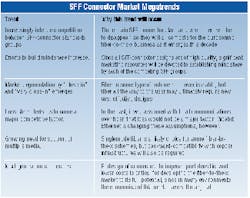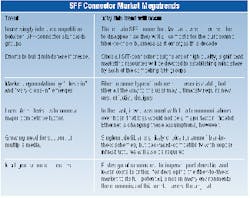Small-form-factor revolution pushes fiber-to-the-x closer
Lawrence Gasman Communications Industry Researchers
A decade or so ago, fiber-to-the-x schemes seldom existed outside the imaginations of futurists and consultants, except for a few soon-abandoned incumbent local-exchange carrier (ILEC) trials. But after years of unkept promises, fiber-to-the-x finally appears to be a technology whose time has come. Fiber-to-the-curb and fiber-to-the-cabinet are already commercial realities. Fiber-to-the-home (FTTH) and fiber-to-the-desk (FTTD) are slowly gaining momentum and may become mainstream during the next five years.
What has created this turnaround? In the past, the justification for fiber-to-the-x has either been merely fanciful (three-dimensional television) or highly specialized (high-end computer-aided design/computer-aided manufacturing). None of these justifications promised a mass market. Today, the Internet is the main reason large numbers of both residential and business users seek the high-bandwidth access that fiber can provide. Moreover, economically, fiber-to-the-x has become more feasible, enabled by a slew of new low-cost components including light sources, detectors, and, above all, connectors.
The new breed of small-form-factor (SFF) connectors is revolutionizing fiber-optic networking, at once enhancing the economic viability of fiber-to-the-x schemes and enabling equipment manufacturers to build more ports into the same sized box. It is important to realize, however, that by helping to create a large and growing commercial fiber-to-the-x market, SFF connector vendors are creating new territory for fiber. Recent studies on both optical components and fiber-to-the-x markets published by Communications Industry Researchers (Charlottesville, VA) reveal some of the key trends in SFF connectors. The Table summarizes the major trends.
Unfortunately for users, one trend that will not occur is the standardization of SFF connectors around a single design. (Although transceiver manufacturers have a small-form-factor multisource agreement that specifies a common footprint for high-density fiber solutions regardless of connector type.) Three connector designs-the LC by Lucent Technologies, the VF-45 by 3M, and the MT-RJ by AMP (now part of Tyco Electronics) and others-have such large installed bases that the disappearance of any one of these designs appears highly unlikely.Things could have been worse. When SFF connectors first appeared, there were five or six competing designs. (Ed. Note: Other designs currently on the market include the Opti-Jack from Panduit Corp., the LX.5 from ADC Telecommunications, and the MU developed by NTT of Japan. A team led by Siecor also has introduced the SC/QC and SC/DC.) Although the clout of each of the three main SFF groups will enable these camps to shape the market, the future of this market will ultimately be determined by the needs of the service provider and private networks in which the SFF connectors are used.
One of these needs is certain to be good loss characteristics. In past fiber-to-the-x schemes, this was of little concern. It was assumed that "close-in" fiber would carry data at rates that would not challenge the loss characteristics of low-end fiber components. But for fiber-to-the-cabinet and -desktop schemes, Gigabit Ethernet, which is beginning to emerge as the premises network protocol of choice, requires low-loss connectorization. (This can be achieved, for example, by factory polishing of the plugs and jacks, which takes the guesswork out of measuring loss.) Indeed, the demanding characteristics of Gigabit Ethernet have challenged one of the most commonly accepted assumptions about fiber-to-the-x; namely, that it will be deployed on a multimode fiber infrastructure. Now, fiber-to-the-x on singlemode fiber may also be required.This trend may give something of a boost to the LC connector. The LC reflects the demanding requirements of the public network, where it is the dominant SFF connector. But from a marketing perspective, the LC would have to be repositioned. Today, it is largely viewed as a costly, higher-end solution best suited for longer-haul, singlemode backbone applications.
In terms of product design, the LC's rugged low-loss characteristics may already adapt well to the needs of the high-end data-communications segment of the fiber-to-the-x market. Lucent uses LC connectors in its structured cabling system. And the arrival of vertical-cavity surface-emitting laser (VCSEL)- and light-emitting diode (LED)-based light sources that use LCs may facilitate its use in close-in fiber markets. In addition to backing from Lucent, the LC connector has the support of Hitachi, IBM Microelectronics, Kyocera, Methode Electronics, Molex, MRV Communications, and Sumitomo Electric Lightwave.
Given the potential success of the LC in at least one segment of the fiber-to-the-x market, Lucent and other backers of the LC may not worry too much when LC detractors criticize the connector as being little more than an old-fashioned SC connector in miniature. That said, there is little doubt that the fiber-to-the-x market needs innovative solutions that can either lower the cost directly or increase port densities on optical-networking boxes deployed in that infrastructure.
While the LC is highly robust, it is perhaps the most conventional approach to SFF design. The LC is ferrule-based and uses an insertion/ release mechanism similar to an ordinary telephone plug. It is also a single-fiber ferrule. In the most cost-sensitive sectors of the fiber-to-the-x market (FTTH and FTTD), this design may make the LC less competitive than other connector approaches that were designed, in part, to support "close-in" fiber applications.
In contrast to the LC, the MT-RJ connector can accommodate two fibers in one ferrule. According to the MT-RJ's backers, using the MT-RJ can save 20% to 30% in connector costs over single-fiber systems. The low cost is due in part to the fact that the MT-RJ does not require fiber polishing or epoxy gluing, which in turn reduces the time and skills needed for installation. MT-RJ connectors can, it is claimed, be installed in less than one minute.
3M's VF-45 connector is a ferruleless interface that reduces cost by sliding the cable into molded plastic V-groove clamps rather than using precision metallic parts. Reportedly, the VF-45 as a solution is just one-seventh the cost of traditional fiber connectors. The VF-45 has many advantages, but the main one is that by eliminating precision parts and connecting the bare fiber in a V-groove, it offers the lowest cost potential.
MT-RJ technology can be traced back to a manufacturing method developed by NTT. However, the MT-RJ connector did not start shipping until mid-1998, and it was not until 1999 that a field-installable version of the MT-RJ was available. But despite the relatively recent emergence of the MT-RJ as a commercial product, it has a long list of backers. There are at least 30 companies now using MT-RJ connectors for their component and systems-level products. These include 3Com, Cabletron, Cisco, Allied Telesyn, Extreme Networks, Foundry Networks, Fujikura, Furukawa, Hewlett-Packard, Krone, Molex, Nortel/Bay Networks, Siecor, Sumitomo, XLNT, and Xylan.
This list is impressive, especially since building mindshare among the component and systems vendors is currently a strategic priority for the SFF connector manufacturers. End users do not appear to perceive notable differences in quality among the various SFF connectors. Indeed, many component and systems manufacturers use more than one kind of connector. Therefore, connector vendors will increasingly pursue extensive-and expensive-efforts to educate customers about the joys of a particular connector design.
Formal organizations to promote particular SFF designs already exist. The VF-45 Action Group, for example, works to increase mindshare for 3M's VF-45 product. The VF-45 is part of 3M's Volition cabling system, which also includes patch panels, cable, media converters, and even local-area-network switches. In addition to 3M, members of this group include Corning and Siemens Microelectronics. The MT-RJ Alliance is another group, which backs AMP's competing architecture. The goal of these groups is to champion their chosen connector design in standards organizations and industry forums, through customer seminars and training, and through the facilitation of further product design and development. There is already a well-developed understanding among the members of both groups that educating original equipment manufacturers and end users about how these products can facilitate fiber-to-the-x is the key to success in that marketplace.
To be effective, such groups must be forward looking and proactive. These groups exist to help generate revenue from emerging fiber-to-the-x opportunities and to lay the groundwork for the next-generation SFF connectors best suited to these opportunities. In this context, it is the VF-45/Volition group that has probably moved the furthest. While Lucent and the companies involved in the MT-RJ program have been pushing their product as a solution for those who have already chosen fiber, the Volition system is specifically marketed as an offering that proves that fiber-to-the-cabinet makes good economic sense.
The Volition approach clearly takes on copper as a competitor, stressing the many reasons (higher bandwidth, greater reliability, immunity from interference, larger distances between repeater stations, etc.) for choosing fiber over copper. All of the vendors in the SFF space clearly understand that for the time being, these products must fit into the existing copper infrastructure with a minimal amount of disruption. That means backward-compatibility to copper faceplates and connecting hardware. AMP, for example, markets a connector that combines its multifiber ferrule with a traditional housing that maintains the same connecting hardware as the existing copper infrastructure. And while the backers of the VF-45/Volition solution unabashedly push fiber as the primary solution for customers, 3M still offers a copper solution where required.
The fiber-to-the-x market can be segmented in a variety of ways. For the purposes of the SFF connector business, it is useful to think of the market as consisting of two segments-the "close-in" segment and the "very-close-in" segment (see Figure). The close-in segment takes fiber closer to the user, but it stops short of going all the way to the desk or to the home. This close-in market exists today and consists of fiber-to-the-cabinet and fiber-to-the curb schemes.
The very-close-in segment, consisting of FTTH and FTTD, has yet to become a reality. Bandwidth-hungry multimedia applications already provide an impetus for bringing fiber all the way to users, but there is still a lot of work to be done. Only 3% of fiber premises networks include FTTD. For that number to jump significantly, the industry must work toward providing an ultra-low-cost and easy-to-install solution. While there is little doubt that SFF connectors are changing the economics of fiber-to-the-x, the full potential of fiber-to-the-x may not be realized until a new generation of SFF connector products appears on the market.
Lawrence Gasman is president of Communications Industry Researchers (Charlottesville, VA).


